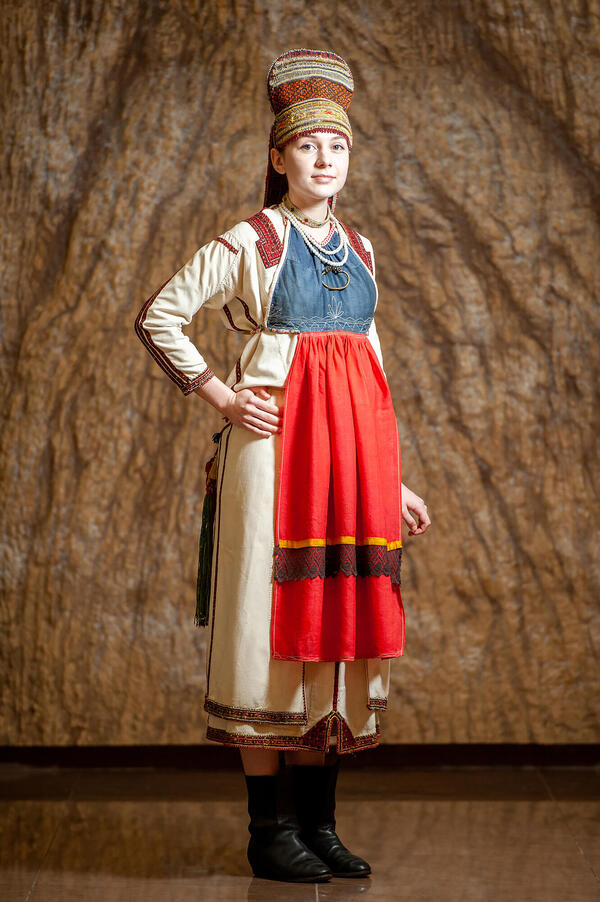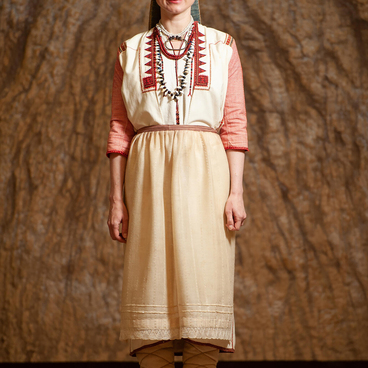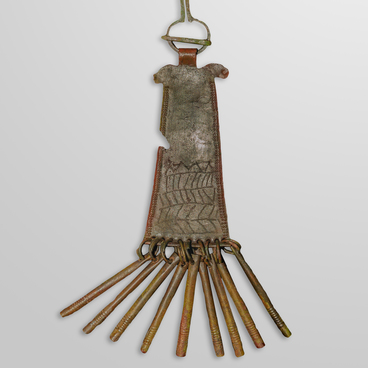The full clothing ensemble of a young Erzya woman consists of a shirt — panar, unfastened tunic — rutsya, headdress — soroka, apron with a bib — zapon, hip ornament — pulokarx (or draznyamokarx) and leather half-boots — koty. The core of the ensemble is a tunic-shaped panar shirt. The most striking and expressive part of the shirt’s decoration throughout history was embroidery.
A festive costume is complemented by a garment made of canvas, which in most areas was called a rutsya. It was sewn from quality hemp or cotton cloth. The rutsya was embroidered with narrow rows of oblique stitches, decorated with beads and sewn rows of scaly sequins.
A new type of apron with a bib — zapon — was introduced into the costume of the local Erzya women in the middle of the 19th century. It was made of fabrics of different colors, for example, a red apron with a blue bib, decorated with machine stitching. The edge of the bib is finely gathered and decorated in the lower third with a band of black lace with a serrated border and a golden band of fabric.
The various decorations included in the ensemble create a vivid idea of the traditional Erzya costume. An obligatory ornament of the attire was a chest fibula — syulgam. In this area it is a ring of oval shape with open ends.
The belt complex of the Erzya costume of the Trans-Volga group deserves special attention. It is somewhat different from the complexes of other territorial groups. The hip ornament pulokarx or draznyamokarx has a trapezoidal shape, extending downwards. It is a simplified form of a loincloth, an obligatory element of an Erzya costume. The festive attire is harmoniously supplemented by a karx tsekt — a belt woven on planks.
The pleated boots typical of all Mordovian groups became obsolete early in the Trans-Volga region. The festive footwear of women and girls here were koty — half-boots with pointed toes and trimmed with scalloped edges and copper plaques. Shoes were ordered from Russian and Tatar craftsmen. All elements of the Erzya costume of the Trans-Volga group complemented each other harmoniously. The structural design of the attire was distinguished by the purity of lines, accentuated by carefully considered color accents and laconic forms of removable jewelry.
A festive costume is complemented by a garment made of canvas, which in most areas was called a rutsya. It was sewn from quality hemp or cotton cloth. The rutsya was embroidered with narrow rows of oblique stitches, decorated with beads and sewn rows of scaly sequins.
A new type of apron with a bib — zapon — was introduced into the costume of the local Erzya women in the middle of the 19th century. It was made of fabrics of different colors, for example, a red apron with a blue bib, decorated with machine stitching. The edge of the bib is finely gathered and decorated in the lower third with a band of black lace with a serrated border and a golden band of fabric.
The various decorations included in the ensemble create a vivid idea of the traditional Erzya costume. An obligatory ornament of the attire was a chest fibula — syulgam. In this area it is a ring of oval shape with open ends.
The belt complex of the Erzya costume of the Trans-Volga group deserves special attention. It is somewhat different from the complexes of other territorial groups. The hip ornament pulokarx or draznyamokarx has a trapezoidal shape, extending downwards. It is a simplified form of a loincloth, an obligatory element of an Erzya costume. The festive attire is harmoniously supplemented by a karx tsekt — a belt woven on planks.
The pleated boots typical of all Mordovian groups became obsolete early in the Trans-Volga region. The festive footwear of women and girls here were koty — half-boots with pointed toes and trimmed with scalloped edges and copper plaques. Shoes were ordered from Russian and Tatar craftsmen. All elements of the Erzya costume of the Trans-Volga group complemented each other harmoniously. The structural design of the attire was distinguished by the purity of lines, accentuated by carefully considered color accents and laconic forms of removable jewelry.




